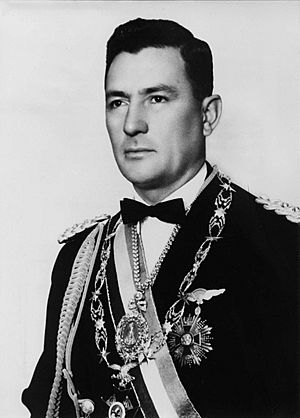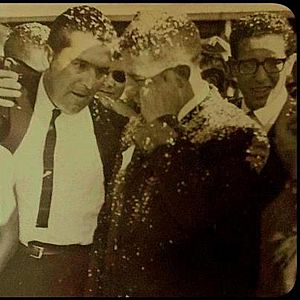René Barrientos facts for kids
Quick facts for kids
René Barrientos
|
|
|---|---|

René Barrientos, 1967
|
|
| 47th President of Bolivia | |
| In office 6 August 1966 – 27 April 1969 |
|
| Vice President | Luis Adolfo Siles Salinas |
| Preceded by | Alfredo Ovando Candía |
| Succeeded by | Luis Adolfo Siles Salinas |
| In office 26 May 1965 – 2 January 1966 Serving with Alfredo Ovando Candía
|
|
| Vice President | Vacant |
| Preceded by | Himself (as president) |
| Succeeded by | Alfredo Ovando Candía |
| In office 5 November 1964 – 26 May 1965 |
|
| Vice President | Vacant |
| Preceded by | Víctor Paz Estenssoro |
| Succeeded by | Himself (as co-president) |
| 30th Vice President of Bolivia | |
| In office 6 August 1964 – 4 November 1964 |
|
| President | Víctor Paz Estenssoro |
| Preceded by | Juan Lechín |
| Succeeded by | Luis Adolfo Siles Salinas |
| Personal details | |
| Born |
René Barrientos Ortuño
30 May 1919 Tarata, Cochabamba, Bolivia |
| Died | 27 April 1969 (aged 49) near Arque, Bolivia |
| Cause of death | Helicopter crash |
| Resting place | Cochabamba, Bolivia |
| Political party | Popular Christian Movement (1966–1969) Revolutionary Nationalist Movement (before 1964) |
| Other political affiliations |
Front of the Bolivian Revolution (political alliance) |
| Spouses | Carmen Porro Castillo Marta Cuéllar Landívar Rose Marie Galindo de Ugarte |
| Parents | Antonio Barrientos Ercilia Ortuño |
| Education | Military College of the Army Military College of Aviation |
| Signature | |
| Military service | |
| Allegiance | |
| Branch/service | |
| Years of service | 1938–1964 |
| Rank | |
| Awards | |
René Barrientos Ortuño (born May 30, 1919 – died April 27, 1969) was a Bolivian military leader and politician. He served as the 47th president of Bolivia two times. His first term was from 1964 to 1966, and his second was from 1966 to 1969. For part of his first term, he shared power with Alfredo Ovando. Before becoming president, he was the 30th vice president of Bolivia in 1964.
General Barrientos became president after a military takeover in 1964. This event removed President Victor Paz Estenssoro from power. During his time as president, Barrientos and the army worked to stop groups that opposed his government. This included a famous guerrilla group led by Che Guevara in 1967.
Contents
Early Life and Military Career
René Barrientos was born in Tarata, a town in the Cochabamba region of Bolivia. His father was of Spanish background, and his mother was Quechua. When he was a child, his father passed away. René was then sent to live in a Franciscan orphanage.
At age 12, he left the orphanage. He attended a private high school and worked odd jobs to pay for his studies. After finishing high school, he joined the military academy in La Paz. He became a professional military officer, graduating in 1943. He also earned his pilot's license in 1945.
In the 1940s, he became interested in the Revolutionary Nationalist Movement (MNR) party. This party aimed for big changes in Bolivia and was led by Víctor Paz Estenssoro. Barrientos played a role in the Bolivian National Revolution of 1952. During this revolution, the MNR took control of the country. Barrientos was given the important task of flying to bring back the revolutionary leader, Víctor Paz Estenssoro, who was living outside the country. In 1957, Barrientos was honored by being named the commander of the Bolivian Air Force.
A Popular General
Barrientos became well-known across Bolivia for his brave actions. In 1960, for example, a live parachute jump show by Bolivian Air Force soldiers went wrong. Three of 15 parachutists died because their equipment failed. This happened in front of a large crowd.
As the Air Force commander, Barrientos decided to show that the equipment was not faulty. He jumped from an airplane himself, using one of the parachutes that had failed earlier. He wanted to prove it was just bad luck, not bad equipment or training. This event made him very popular with many people. The ruling MNR party also helped his popularity. They often praised General Barrientos, showing him as a great example of a new kind of military leader.
By the early 1960s, the MNR party started to face problems. Its leaders had disagreements about personal matters and policies. However, Barrientos's popularity continued to grow. President Paz Estenssoro, who was in his second term, started to rely more on the military. He needed their help to bring order to parts of the country where rival groups were fighting each other. Disarming these groups became important, which increased the military's role. Barrientos was the most popular of these military leaders.
Becoming President
In 1961, President Paz Estenssoro changed the Bolivian Constitution. This allowed him to run for president again right away. He felt he was the only one who could keep the MNR party together. However, many Bolivian politicians did not like this move. They believed it was unfair and that others should have a chance to be president.
Surprisingly, Paz chose General Barrientos as his running mate for the 1964 elections. They both took office on August 6, 1964. Just three months later, Barrientos worked with the Army Commander Alfredo Ovando. They led a military takeover that removed Paz from power. Barrientos then became co-president with General Ovando.
Barrientos wanted to use his popularity to run for president in an election. With the military now in charge, he had their full support. He stepped down as co-president in early 1966. He then ran as a candidate for president in the general elections held in July 1966. Many important civilian leaders, like Paz, Hernán Siles, and Juan Lechín, were living outside the country. Because of this, Barrientos easily won the election. He was sworn in as president in August 1966.
Barrientos as President
General Barrientos was a very charming leader. He was popular with everyday Bolivians throughout his presidency. He could speak Quechua very well, which is an important native language among Bolivian farmers. This helped him connect with many people.
Barrientos was good at speaking to large groups. He could present himself as both a leader who cared about ordinary people and someone who believed in strict rules. He claimed to be a strong Christian and worked closely with the church. For the 1966 elections, he chose Dr. Luis Adolfo Siles, the leader of a small Christian Democrat Party, as his running mate.
He was strongly against communism and supported a free market economy. He accepted more military help from the United States. He also allowed special forces to be trained to fight against possible communist uprisings. This made him very popular with the US government.
The 1967 Guerrilla Conflict
Barrientos had a chance to show his strong anti-communist beliefs in 1967. A guerrilla group was found operating in southeastern Bolivia. This group was led by the famous Argentine-Cuban revolutionary Ernesto "Che" Guevara.
Barrientos was worried that Guevara might become popular among the miners in the country. So, he took strong actions in those areas. This included a tragic event known as the San Juan massacre. On June 24, 1967, soldiers opened fire on miners, killing about 30 men and women. Guevara hoped this event would make the miners join his communist cause. However, the miners signed an agreement with the government-owned mining company, which weakened Guevara's efforts.
The fight between the Bolivian army under President Barrientos and Che Guevara's group continued. Eventually, the Bolivian Army Rangers captured Guevara. Barrientos directly ordered Guevara's execution after he was captured in October 1967.
Political Challenges and Barrientos's Death
While the capture of Guevara made Barrientos more popular for a short time, it also led to more problems. As the army fought the guerrillas, the miners of Siglo XX, a state-owned mining town, supported the rebels. This led Barrientos to send troops to take back control, resulting in the San Juan massacre.
In 1968, a major scandal happened. Barrientos's trusted friend and Minister of Interior, Antonio Arguedas, disappeared with Che Guevara's captured diary. The diary soon appeared in Havana, Cuba. From abroad, Arguedas admitted he was secretly a Marxist supporter. He accused Barrientos and many of his helpers of being paid by the CIA. This event embarrassed the government and made people question Barrientos's judgment.
After the mining massacres and the fight against the guerrillas, some people saw Barrientos as a harsh leader who served foreign interests, even though he presented himself as a democrat. To fix his image and improve his good relationship with Bolivian farmers, Barrientos began traveling across the country. He visited even the smallest and most remote villages to explain his actions. This tactic had worked well for him in the past, and he hoped to regain public support.
However, on April 27, 1969, while flying into Arque Municipality, Cochabamba Department, Barrientos was killed in a helicopter crash. Some people believe it might have been an assassination, but this has never been proven.
See also
 In Spanish: René Barrientos Ortuño para niños
In Spanish: René Barrientos Ortuño para niños


